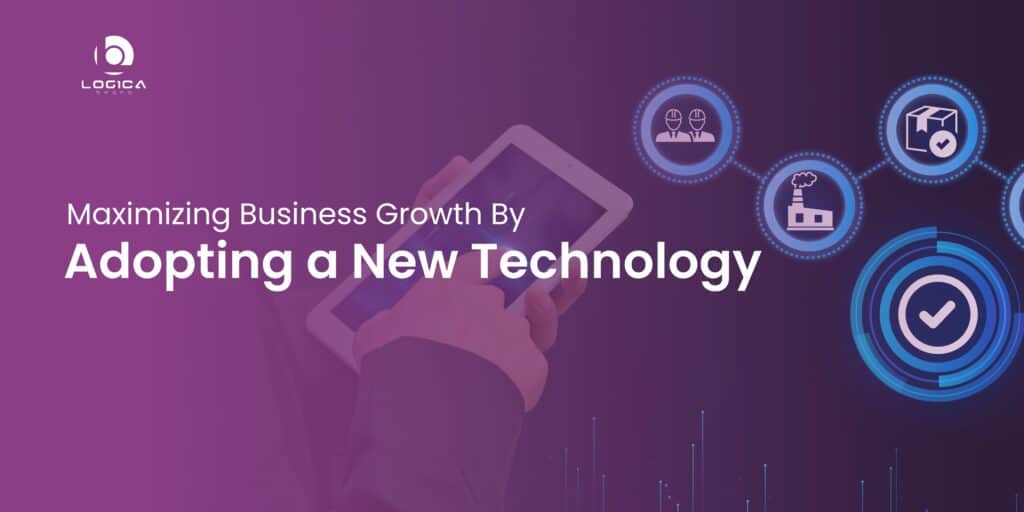In today’s dynamic world achieving company growth is very much critical for the companies not only to survive but also prosper. Businesses in all industries strive for expansion since it delivers some benefits such as increased market share, improved profitability and long-term success. And guess what? Adopting new technology in business is driving business growth.
Here in this blog, you will get to learn about how companies nowadays maximize their growth with the help of technology and how they are adopting new technology in business. You will also get to know about the impact of technology on business growth.
Let’s get started!
Business growth in today’s competitive landscape by adopting new technology
Staying relevant and successful in today’s competitive landscape is very much tough. Prioritizing company growth is a vital component to achieve this. Adopting new technology in business is also important for a business to success. Adopting new technology in business can improve not just your efficiency but also your entire performance, providing a competitive advantage over your competitors. So, why not use cutting-edge technology to move your company forward?
Adopting new technology in business allows businesses to simplify operations, automate monotonous jobs, and eliminate human mistakes. Companies may optimize their operations by using modern software, tools, and systems, resulting in increased productivity in workplace. As a result, organizations may better organize their resources, focus on key capabilities, and generate value for their consumers.
Furthermore, adopting new technology in business allows them to improve their client experience and engagement. Customers demand smooth and individualized experiences with businesses in the digital age. Businesses may acquire significant insights into consumer behavior, preferences, and requirements by embracing developing technologies such as artificial intelligence, machine learning, and data analytics. This data may be used to provide tailored experiences, establish focused marketing initiatives, and strengthen customer connections, eventually boosting customer loyalty and happiness.
Corporate development is critical, and embracing new technology is critical to attaining it. Businesses may improve operational efficiency, customer experience, innovation capabilities, and strategic decision-making by embracing technology. Embracing new technology enables firms to flourish in the face of competition, accelerate their growth trajectory, and establish themselves as industry leaders. In today’s fast-paced corporate climate, staying current on technological advances is not a choice; it’s a must for long-term success.
Understanding the impact of adopting new technology in business growth
Technology has transformed the way business functions and has become a critical driver of development and success. Exploring the many forms of technology that firms might use is an important part of understanding the influence of technology on company growth. The possibilities are endless, ranging from advanced data analytics and artificial intelligence to cloud computing and automation. Businesses may use these technologies to simplify operations, increase efficiency, make data-driven choices, improve customer experiences, and gain a competitive advantage in the market.
Many successful firms have successfully used technology to propel their expansion. Amazon is one such example. Amazon has changed the retail business via its inventive use of technology. Customers benefit from tailored shopping experiences provided by its advanced algorithms and recommendation systems, resulting in higher sales and customer loyalty. Furthermore, Amazon’s use of robotics and automation in its fulfillment centers has increased operational efficiency and lowered costs, allowing the business to scale quickly and enter new markets.
Furthermore, a survey conducted by Deloitte revealed that 85% of executives believe artificial intelligence (AI) will have a significant impact on their businesses’ growth prospects. The study also found that companies leveraging AI technologies experienced a 39% increase in revenue.
Overall, adopting new technology in business shown to be a catalyst for development and success. Businesses may improve their operations, acquire a competitive edge, and achieve significant revenue growth by embracing and strategically employing the proper technology. The data and examples provided demonstrate technology’s revolutionary impact in altering the future of enterprises in a variety of industries.
Overcoming challenges while adopting new technology in business
Overcoming challenges while adopting new technology in business may be a difficult process since it requires dealing with a variety of variables such as opposition, organizational impediments, and technological limits. However, by using certain techniques and best practices, it is feasible to boost the likelihood of effective technology adoption.
Here are some of the techniques to overcome challenges while adopting new technologies:
● Understand user needs
Before adopting new technology in business, it is important to understand the end-users’ wants and expectations. Gather information about their pain areas, preferences, and expectations through user research, interviews, and surveys. You boost the chance of acceptance and adoption by aligning technology with user demands.
● Provide training and support
A lack of understanding and familiarity is a typical impediment to technology adoption. Users should be given extensive training sessions to assist them comprehend the benefits and capabilities of the new technology. Furthermore, offer continuous learning and professional improvement with any concerns or difficulties that may occur during the adoption process.
● Communicate benefits and value
Communicate clearly the benefits and value that the technology provides to users and the company as a whole. Highlight how it can help to simplify procedures, increase efficiency, cut costs, or improve the user experience. Demonstrating the actual benefits may inspire user excitement and buy-in.
● Start with small pilot projects
Adopting new technologies on a broad scale may be daunting and hazardous. Begin with tiny pilot projects or restricted deployments to evaluate the technology under controlled conditions. Collect feedback, analyze the outcomes, and apply the learnings to fine-tune the implementation plan before scaling up.
● Address security and privacy concerns
Adopting new technology in business frequently causes security and privacy issues. Address these issues front on by installing strong security measures, following privacy legislation, and publicizing the procedures taken to protect data. Building trust and guaranteeing data security can help to reduce adoption resistance.
● Foster culture of innovation
Create a culture and values that change and supports innovation. Encourage staff to experiment with new technology, express their thoughts, and offer feedback. Individuals or teams who contribute to effective technology adoption should be recognized and rewarded. Adoption may be greatly aided by a supportive and inventive culture.
● Involve stakeholders
Engage stakeholders early in the technology adoption process, including employees, managers, and important decision-makers. Seek their feedback, address their issues, and include them in decision-making. Stakeholders are more inclined to support and promote the technology adoption program when they feel included and have a feeling of ownership.
● Monitor and measure progress
Continuously monitor technology adoption progress and assess its influence on key performance indicators (KPIs). Collect and evaluate data to determine user satisfaction, adoption rates, productivity gains, or cost savings. Utilize these insights to discover areas for improvement and make the required changes to guarantee effective adoption.
You may overcome barriers in technology adoption and boost the possibilities of successful implementation by combining these tactics and adjusting them to the unique environment of your firm. Remember that technology adoption is a continuous process that needs constant examination and improvement to attain the best outcomes.
Maximizing business growth by adopting new technology in Nepal
Maximizing business growth by adopting new technology is the most important approach for Nepalese enterprises seeking to compete in an increasingly competitive market. Nepal, a developing country with a strong entrepreneurial spirit can use technology to overcome obstacles, create innovation, and speed prosperity. Business in Nepal may alter their operations and increase their competitiveness on both local and global by adopting new technology in business.
Identifying company goals and integrating them with technological strategy is of the utmost importance in Nepal. When adopting new technology in business, Nepalese businesses’ particular demands, such as increasing supply chain management, boosting tourism experiences, or growing e-commerce capabilities, should be considered. A technology audit enables firms to examine their existing infrastructure, identify gaps, and investigate appropriate technological choices.
Staying informed about technological advancements and trends relevant to Nepal is crucial. Emerging technologies like mobile apps, e-commerce platforms, digital payment systems, and data analytics have the potential to transform the way Nepalese business’s function. Businesses in Nepal can make educated judgments about the best solutions for their respective sectors and target audiences by researching and understanding these technologies.
Fostering an innovative culture is critical for maximizing corporate success through technology adoption in Nepal. Employees can be encouraged to adopt technology by giving training opportunities and encouraging cross-departmental collaboration. This makes it easier to create and adopt cutting-edge technology, resulting in better goods, services, and processes.
Because of the rapid growth of technology, keeping nimble and adaptive is crucial in Nepal. Continuously investigating emerging technology, being current on industry trends, and being open to altering tactics and implementing new solutions guarantee that firms remain competitive in a volatile environment.
Nepalese companies may also seek expert advice to help them negotiate the intricacies of technology adoption. Using technology consultants, engaging with technology partners, and using local and international networks may give significant insights, best practices, and assistance in adopting technology solutions adapted to the Nepalese business landscape.
Businesses in Nepal can unleash new development prospects, increase operational efficiencies, and stimulate innovation by properly using technology. Strategic use of technology may boost competitiveness, broaden market reach, and contribute to Nepal’s overall economic growth and development.
Future trends and technologies for business growth
Staying current on the newest trends and technologies is not just essential; it is also required for organizations that want to prosper in the future. Technology’s fast growth has the ability to disrupt industries and transform business environments. Businesses may proactively adapt and grab possibilities for development by actively investigating emerging technologies and understanding their potential effect.
Businesses get a competitive advantage by embracing continuing technological improvements. It enables them to differentiate themselves from competition by providing novel products, services, or experiences that adapt to evolving client demands and expectations. Early adopters of new technology frequently become industry leaders, earning market share and developing brand loyalty.
In addition to having a competitive edge, firms may boost efficiency and production by embracing technology. Automation, artificial intelligence, and machine learning may help organizations streamline operations, automate repetitive jobs, and optimize processes, allowing them to better manage resources and provide higher-quality results in less time. This not only increases productivity but also allows staff to focus on higher-value jobs and strategic projects.
Furthermore, keeping up with trends and advancements is essential for improving consumer experiences. Customers today want companies to be customized, frictionless, and convenient. Businesses may give tailored suggestions, AI-powered chatbots for customer service, smart user interfaces, and seamless omnichannel experiences by using technology. Such improvements increase consumer pleasure, loyalty, and advocacy, resulting in a long-term competitive advantage.
Keeping up with the newest trends and advancements is about more than simply reaping short-term rewards; it is also about future-proofing the firm. Businesses may predict upheavals, discover new market possibilities, and pivot their strategy by continually monitoring and evaluating trends. Businesses must be agile and adaptable in order to succeed in an ever-changing commercial world.
Moreover, remaining current opens new prospects for cooperation and collaborations. Businesses can find possible partners with comparable strengths and skills by spotting upcoming trends and technology. Collaborative activities may open up new markets, speed innovation, and enable resource sharing, eventually supporting mutual progress.
Staying current on trends and developments is a strategic need for firms seeking to achieve long-term success. Businesses may position themselves for success in a dynamic and competitive business world by actively investigating emerging technologies, evaluating their potential effect, and adjusting proactively.
Gaining a competitive edge, increasing efficiency and productivity, improving customer experiences, allowing data-driven decision-making, minimizing risks, promoting innovation, and recruiting top personnel are all advantages. Businesses can safeguard their position and prosper in an ever-changing digital environment by embracing the future now.
Conclusion
Maximizing business growth through technology adoption is a vital strategy in today’s competitive landscape. Businesses that embrace technology may streamline operations, increase efficiency, improve customer experiences, and gain a substantial competitive edge. Continuous technology developments are critical because they allow firms to stay ahead of the curve, foresee market trends, and react to changing client expectations. Businesses must proactively investigate developing technologies, comprehend their potential effect, and connect them with their unique goals and industry requirements.










